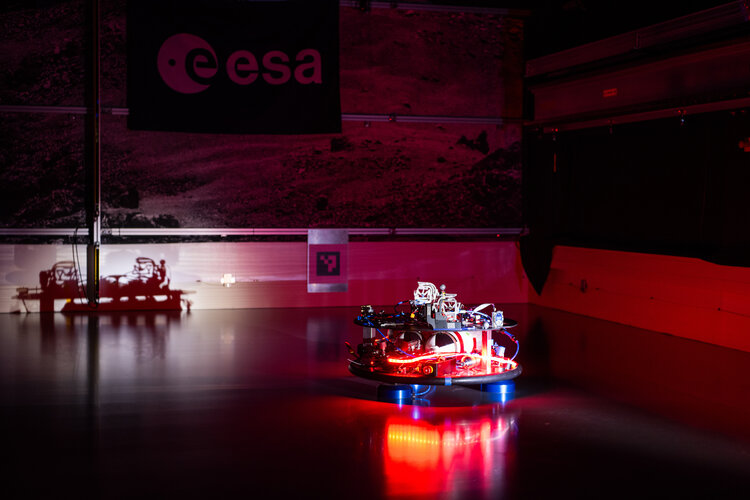AI enhancements drive Mars rover discoveries
Wednesday, 17 July 2024 14:44 Artificial intelligence is transforming how scientists analyze rock samples collected by the Perseverance rover on Mars.
For nearly three years, Perseverance has been utilizing AI to autonomously identify minerals in Martian rocks. This innovative use of AI on Mars marks a significant step toward creating "smart" spacecraft capable of independent scientific exploration.
The AI techno
Artificial intelligence is transforming how scientists analyze rock samples collected by the Perseverance rover on Mars.
For nearly three years, Perseverance has been utilizing AI to autonomously identify minerals in Martian rocks. This innovative use of AI on Mars marks a significant step toward creating "smart" spacecraft capable of independent scientific exploration.
The AI techno ESA prepares for close encounter with Asteroid Apophis in 2029
Wednesday, 17 July 2024 14:44 Thirty years ago, on July 16, 1994, astronomers witnessed the dramatic collision of the Shoemaker-Levy 9 comet with Jupiter, sparking significant interest in planetary defence and raising the question: "Could we prevent such an event from happening to Earth?"
Today, ESA's Space Safety programme takes a significant step towards answering this question. The programme has been authorized to b
Thirty years ago, on July 16, 1994, astronomers witnessed the dramatic collision of the Shoemaker-Levy 9 comet with Jupiter, sparking significant interest in planetary defence and raising the question: "Could we prevent such an event from happening to Earth?"
Today, ESA's Space Safety programme takes a significant step towards answering this question. The programme has been authorized to b New analysis of Cassini data yields insights into Titan's seas
Wednesday, 17 July 2024 14:44 A new study of radar experiment data from the Cassini-Huygens mission to Saturn has yielded fresh insights related to the makeup and activity of the liquid hydrocarbon seas near the north pole of Titan, the largest of Saturn's 146 known moons.
The key takeaway: Using data from several bistatic radar experiments, a Cornell University-led research team was able to separately analyze and esti
A new study of radar experiment data from the Cassini-Huygens mission to Saturn has yielded fresh insights related to the makeup and activity of the liquid hydrocarbon seas near the north pole of Titan, the largest of Saturn's 146 known moons.
The key takeaway: Using data from several bistatic radar experiments, a Cornell University-led research team was able to separately analyze and esti Sun-like stars found orbiting hidden companions
Wednesday, 17 July 2024 14:44 Most stars in our universe come in pairs. While our own Sun is a loner, many stars like our Sun orbit similar stars, while a host of other exotic pairings between stars and cosmic orbs pepper the universe. Black holes, for example, are often found orbiting each other. One pairing that has proved to be quite rare is that between a Sun-like star and a type of dead star called a neutron star.
Most stars in our universe come in pairs. While our own Sun is a loner, many stars like our Sun orbit similar stars, while a host of other exotic pairings between stars and cosmic orbs pepper the universe. Black holes, for example, are often found orbiting each other. One pairing that has proved to be quite rare is that between a Sun-like star and a type of dead star called a neutron star. Teledyne e2v qualifies Space-Ready 8 GB DDR4 memory chip
Wednesday, 17 July 2024 14:44 Teledyne e2v has announced the successful space qualification of its 8 GB DDR4 memory chip, expanding its edge compute solutions for space applications. This marks the completion of Teledyne e2v's initial DDR4 qualification, including all necessary upscreening activities such as temperature cycling, construction analysis, C-SAM, preconditioning, Temperature Humidity Bias, and radiation testing.
Teledyne e2v has announced the successful space qualification of its 8 GB DDR4 memory chip, expanding its edge compute solutions for space applications. This marks the completion of Teledyne e2v's initial DDR4 qualification, including all necessary upscreening activities such as temperature cycling, construction analysis, C-SAM, preconditioning, Temperature Humidity Bias, and radiation testing. TeraNet enhances Space-to-Earth data transfer with laser comms
Wednesday, 17 July 2024 14:44 The University of Western Australia's TeraNet, a network of optical ground stations focused on high-speed space communications, has successfully captured laser signals from a German satellite in low Earth orbit. This achievement signals a potential 1,000-fold increase in communication bandwidth between space and Earth.
Led by Associate Professor Sascha Schediwy from the UWA node at the Int
The University of Western Australia's TeraNet, a network of optical ground stations focused on high-speed space communications, has successfully captured laser signals from a German satellite in low Earth orbit. This achievement signals a potential 1,000-fold increase in communication bandwidth between space and Earth.
Led by Associate Professor Sascha Schediwy from the UWA node at the Int Ramon.Space expands to UK to boost space computing development
Wednesday, 17 July 2024 14:44 Ramon.Space, a leader in space-resilient computing infrastructure, has announced the opening of its new subsidiary, Ramon.Space UK. This move marks the company's first office in Europe, underscoring its commitment to advancing space computing and communications worldwide.
The new UK office will act as a key engineering hub, focusing on driving innovation and accelerating advancements in sp
Ramon.Space, a leader in space-resilient computing infrastructure, has announced the opening of its new subsidiary, Ramon.Space UK. This move marks the company's first office in Europe, underscoring its commitment to advancing space computing and communications worldwide.
The new UK office will act as a key engineering hub, focusing on driving innovation and accelerating advancements in sp Zero-G testing on Europe’s flattest floor
Wednesday, 17 July 2024 13:36
A student team testing a new approach to satellite propulsion came to the flattest floor in Europe – based at ESA’s ESTEC technical centre in the Netherlands – which is used to reproduce the experience of weightless free-floating in two dimensions instead of three.
GPS startup bets on advanced signal to counter jamming threats
Wednesday, 17 July 2024 13:00

GOP platform lays out aggressive space agenda to counter China
Wednesday, 17 July 2024 12:00
Satnav enables medical and emergency response
Wednesday, 17 July 2024 08:35
Satellite navigation is not just about travel directions; its applications extend to search and rescue operations, agriculture, autonomous vehicles, sports and perhaps surprisingly, even health. ESA's NAVISP programme supports European companies in the creation of satnav-powered solutions with all sorts of applications – among them, emergency response and healthcare.
Elon Musk says he's moving SpaceX, X headquarters from California to Texas
Wednesday, 17 July 2024 07:20
Billionaire Elon Musk says he's moving the headquarters of SpaceX and social media company X to Texas from California.
Musk posted on X Tuesday that he plans on moving SpaceX from Hawthorne, California to the company's rocket launch site dubbed Starbase in Texas.
Double trouble: Gaia hit by micrometeoroid and solar storm
Wednesday, 17 July 2024 07:00
Launched in December 2013, ESA’s Gaia spacecraft is on a mission to map the locations and motions of more than a billion stars in the Milky Way with extreme precision.
But it’s not easy being a satellite: space is a dangerous place. In recent months, hyper-velocity space dust and the strongest solar storm in 20 years have threatened Gaia’s ability to carry out the precise measurements for which it is famous.





